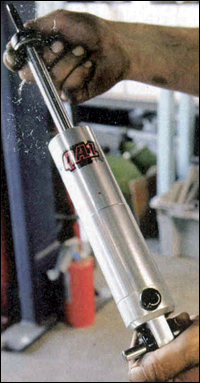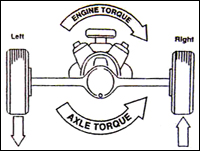 |
| Classic Performance Products |
| Chevelle Street/Strip Rear Suspension Install |
| By Johnny Hunkins |
|
|
|
| As the PHR Street Sweeper Chevelle progresses, we've
had to come face-to-face with a few tough decisions. Like some of you, we've
had to draw the line in the sand, deciding how much "street" "strip"
or "road course" to dial in to each part of the car. With a big-block
under the hood, the Chevelle will be decidedly more street/strip than road
course. Since our ET goal is mid-11s and our pump gas friendly Rat is making
just more than 600 hp, we shouldn't have to go too crazy with the rear suspension,
but it does need to be addressed. We've already installed some rock-solid
CurrieTrac rear control arms from Currie, and that leaves only the springs
and shocks as easy fixes. In the spring department, a modest spring rate
is ideal for both the street and the drags. You need enough compliance (read:
softness) for weight transfer at launch, but enough firmness to prevent
bottoming out and other tire/body clearance problems. Go too far the other
way with firm, and you'll never get traction. After trying a few different
rear springs from the Classic Performance Parts catalog, we settled on a
stock height spring with a slightly higher spring rate. |
Shocks (or dampers, as they're known to engineers) only exist
because springs oscillate, and oscillations, if not controlled, result in
a nauseating ride and bad handling. Put another way too little damping,
and a spring is allowed to bounce uncontrolled but too much damping results
in not enough weight transfer, insufficient absorption, and a buckboard
ride. If you're a math geek, you can select a good non-adjustable shock
for a given spring, but that ain't us we need adjustability. We also need
something modestly priced, so we can still afford the engine we've got brewing.
The answer for our Chevelle was as et of QA1 Stocker Star single adjustable
shocks, which will let us dial-in the damping to closely match our springs.
There's also some latitude for the strip-should we need to soften things
a bit-and they're affordably priced from CPP, sturdy, and attractive (machined
billet). And while we were at it, we picked up the matching shocks for the
front. The last trick up our sleeve was a set of Air Lift Drag Bags. They've
been around for decades as add-ons for trucks, RVs, and campers, but were
hijacked by drag racers long ago for their ability to redistribute weight
of the rear tires. |
We've used them before on the track, and they really work.
Moreover, they're cheap-as in $76 per pair from Summit. The airbags work
because they allow the right rear tire to do more work at launch. Will these
mods do the trick? It's hard to wait, but Rome wasn't built in a day. When
we eventually get to the track for testing and tuning, the airbags and adjustable
shocks will help maximize all that torque. We still have to get the plant
installed, do the trans, cooling, headers, exhaust, fuel system, and many
more punch items (like gauges and wiring), but at least we're still driving
it while we're working on it and that's the whole point. On a final note,
we installed our new springs, shocks, and air bags with help from CPP. CPP's
Anaheim, California, shop is an R&D facility for developing new products.
It's nice to know that companies like CPP work all the bugs out on real
cars first. |
 |
Our recipe for hooking up the Chevelle's rear was simple springs,
shocks, and air bags. The old rear springs might be serviceable, but after
39 years, they've sagged too much for our comfort. The CPP units restore
lost ride height and increase the spring rate slightly for the track work
ahead. The QA1 Stocker Star shocks offer the adjustability we need for the
track at an affordable price, and are rebuildable over the long haul. In
addition, the Air Lift Drag Bags will give us the ability to preload weight
on the right rear tire, so that
hard launches will be more productive. |
|
 |
Technician Jeff Wise helped us install the rear suspension
parts at CPP's Anaheim, California, R&D department. After trying a few
rear springs and measuring the
resulting ride heights, we settled on CPP's RCS603-2HP. They will work fine
with our CPP front springs (PN FC6330-D), which we cut 2 inches. |
|
 |
| Air Lift's Drag Bags kit for '64-'77 GM A-body (PN 60844)
comes with this extra 1-inch spacer (top), which is used only for '73-and-later
"colonnade" cars. We set it aside for our install. |
|
 |
| The air bags go inside the rear springs, with the air barb
facing down into the hole provided in the spacer. You'll need to run the
air line through the spring perch up to the barb, and clip it with the hose
clamps in the kit. We routed the air lines along the brake lines, tying
them off with mylar wire ties from the kit. If you have dual exhausts, don't
forget to install the heat shields (which also come with the kit). Heat
can damage the bag and air line, negating their benefit. |
|
 |
| Install the two air valves (which look like tire valves) in
the rear frame crossmember. You'll need a 5/16-inch drill bit, a pair of
pliers (for the hose clamps), and some 1/2-inch box wrenches to tighten
down the air valve. We ran the air hoses above the gas tank, fishing them
through with a length of welding rod. (A coat hanger will also work fine.) |
|
 |
| Installing the QA1 Stocker Star shocks in the rear is traightforward.
You'll need a 1/2-inch swivel socket and extension for the two top nuts,
and an 11/16-inch impact socket for the lower. We suggest replacing the
four upper shock bolts with longer, 5/16x11/4-inch bolts, as the shock's
upper billet crossbar is thicker than stock. |
|
 |
| Here's where the rubber meets the road-QA1's Stocker Star
shocks have a damper adjustment, which provides 18 discrete dampening settings.
Our springs are noticeably stiffer than stock, so we defaulted to the "11"
setting in the front ("1" is full soft and "18" is full
hard). The rears needed much less damping, and only called for a "3"
setting. Double adjustable Stocker Stars have indepen- dent adjustment for
compression and rebound (for 576 possible settings), and run about $120
more per shock. |
|
 |
| In this photo, you can see how the QA1 adjustment dial clears
the bottom of the lower control arm for easy installation. CPP designed
them that way. The stock control arms will need some clearancing to fit
these larger shocks. You'll have the option of clocking the adjustment dial
to the inside or the outside. Either way, you'll need a screwdriver to access
the dial through the spring coils. |
|
 |
QA1 STOCKER STAR
We chose QA1s Stocker Star shock because we wanted
the ability to tune the suspension without the high price associated with
coilovers. While QA1 is perhaps best known for high-end items, its also
makes an array of affordable, high-quality street pieces, called Stocker
Stars. We paid $184 each for these single- adjustable dampers through CPP.
The selected single-adjustable Stocker Star offers simultaneous adjustment
of compression and rebound via a single dial with 18 detents, ranging from
very soft (setting "1" on the "-" end), to very firm
(setting "18" on the "+" end). Stocker Stars are made
in all the common musclecar sizes, and are direct replacements for the stock
shocks. If you're more strip than street, you may want granular control
with QA1's dual- adjustable Stocker Star (which cost around $300 each).
Compression and rebound are independently adjustable, so plan to spend a
few weekends at the track to really dial it in (there are 576 possible combinations
rebound and compression). |
|
 |
THE DRAG BAG DIFFERENCE
Watch any fast street car at the starting line
and you'll notice two things: the driver-side tire comes up the highest,
and diagonal to that, the right rear tire sinks the lowest into the body.
What you're seeing is engine torque in action. The more torque you make,
the more the car twists. It looks cool, but the side effect is that the
axle doesn't stay level with the Ie thaIl the left. car the right rear tire
unloads, and the left rear has to do most of the work. If you could only
jack more weight on the right rear to offset the axle torque, you'd h ave
more traction available to propel the car forward. This is exactly what
Drag Bags do, and that's why we've got them. In the past, we've run anywhere
between 15 and 35 pounds of air pressure in the right- side (passenger)
bag, and zero in the left-which is really only there to level the ride in
regular driving (in fact, you don't even need the left one if you're feeling
lazy). In traction-limited slick-equipped cars, look for anywhere between
a 0.10 and 0.30 improvement in the quarter-mile. |
|
|


